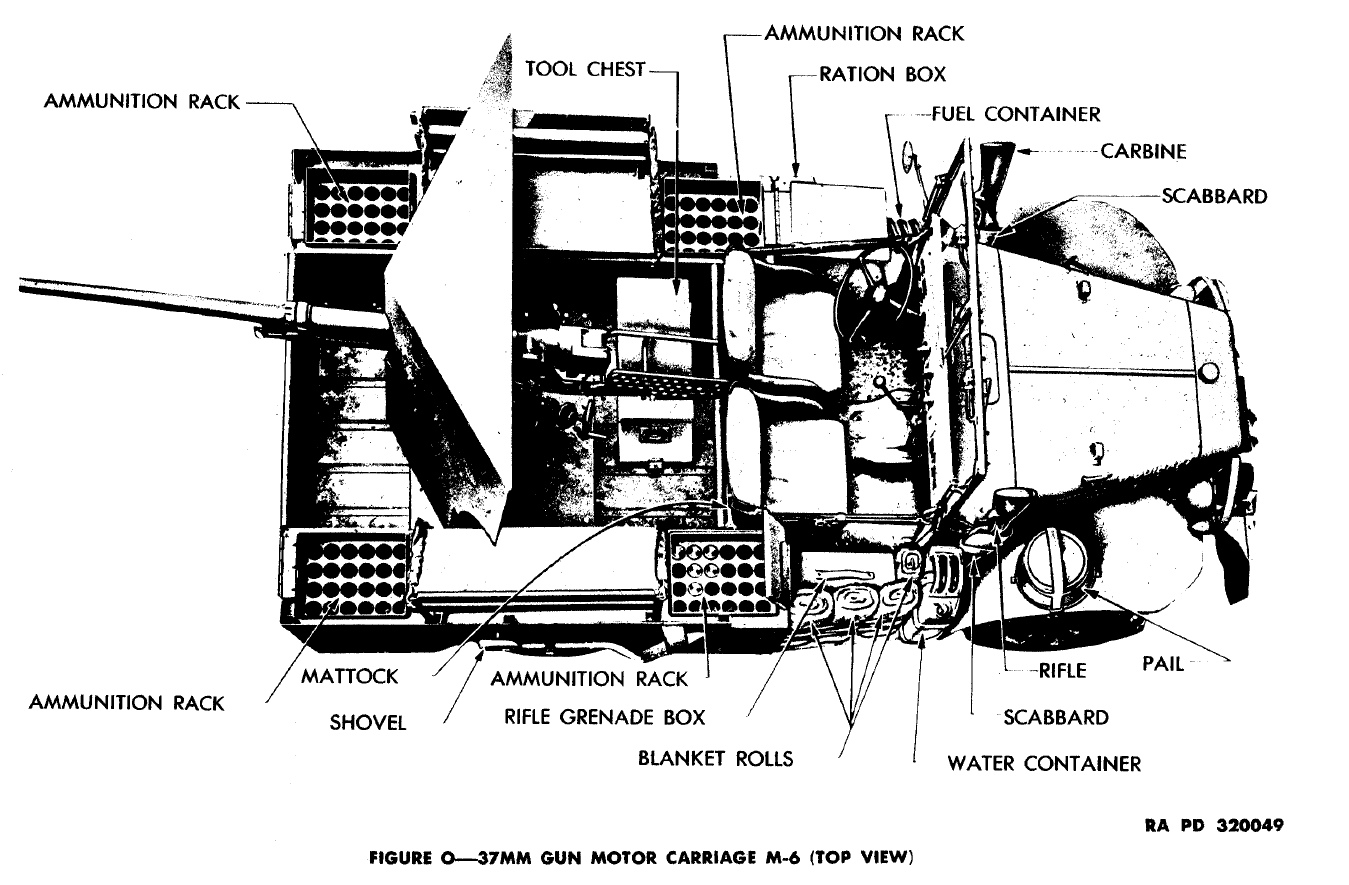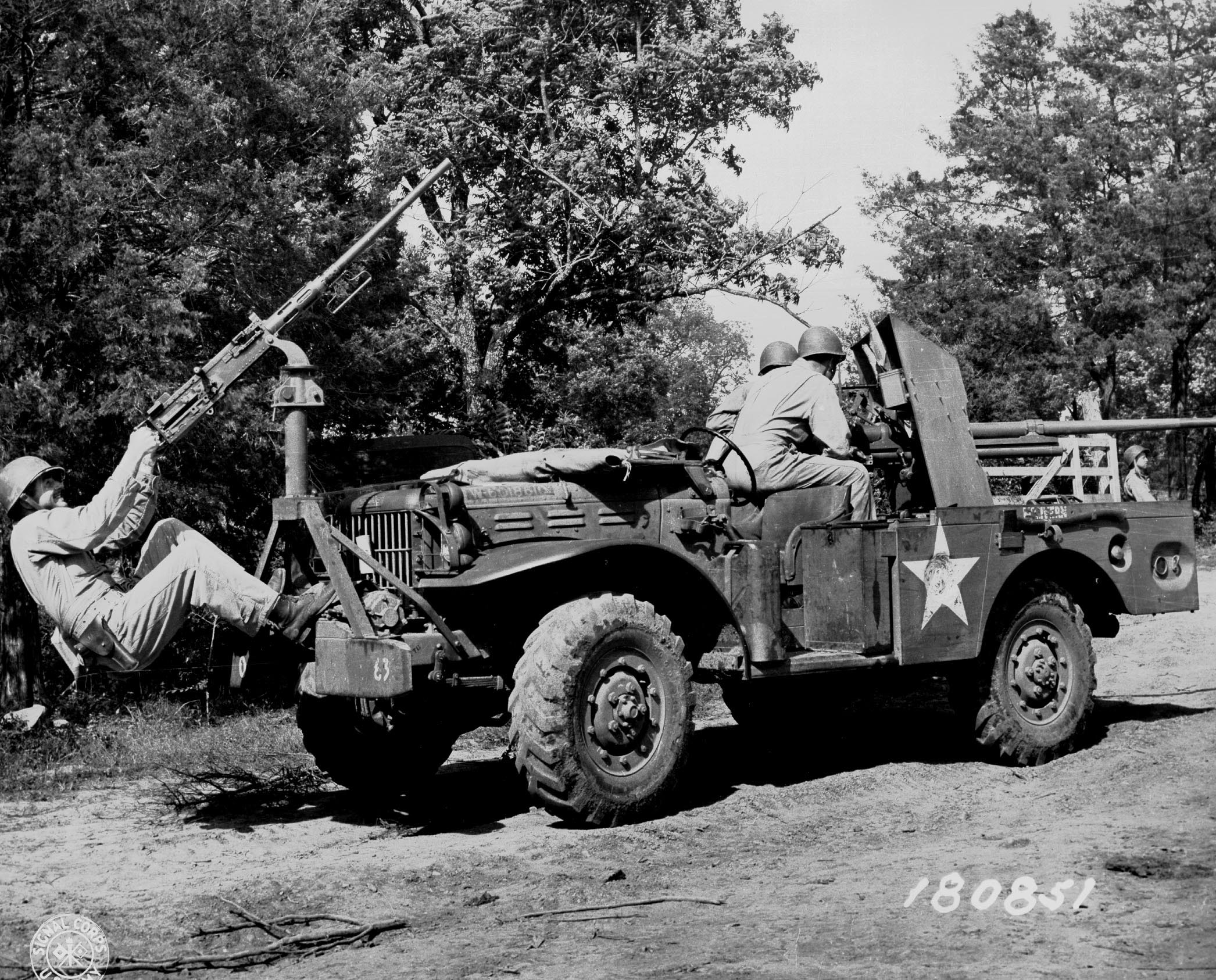M6 Gun Motor Carriage on:
[Wikipedia]
[Google]
[Amazon]
The 37 mm Gun Motor Carriage M6, also known as M6 Fargo, and under the manufacturer (Dodge)'s designation WC55, was a modified Dodge WC52 light truck mounting a light anti-tank gun. It was used by the
 The 37 mm Gun Motor Carriage (GMC) M6 was a modified 3/4-ton 4x4 Dodge WC52 truck with a rear-facing 37 mm M3 gun mounted in its bed ('' portee'') and designated WC55. The gun was normally fired to the rear — it could not be fully depressed when pointed to the front of the vehicle due to blast effects on the crew and vehicle windshield. The gun fired M74 Armor Piercing (AP) Shot that could penetrate of armor at . Other ammunition carried throughout its service life included the Armor Piercing Capped (APC) M51 Projectile (which could penetrate of armor at 500 yd), and the High Explosive (HE) M63 Projectile. Eighty rounds of 37 mm ammunition were carried aboard.
The crew-members were equipped with personal weapons for self-defense.
The 37 mm Gun Motor Carriage (GMC) M6 was a modified 3/4-ton 4x4 Dodge WC52 truck with a rear-facing 37 mm M3 gun mounted in its bed ('' portee'') and designated WC55. The gun was normally fired to the rear — it could not be fully depressed when pointed to the front of the vehicle due to blast effects on the crew and vehicle windshield. The gun fired M74 Armor Piercing (AP) Shot that could penetrate of armor at . Other ammunition carried throughout its service life included the Armor Piercing Capped (APC) M51 Projectile (which could penetrate of armor at 500 yd), and the High Explosive (HE) M63 Projectile. Eighty rounds of 37 mm ammunition were carried aboard.
The crew-members were equipped with personal weapons for self-defense.
 With the design standardized in February 1942, 5,380 GMC 37 mm M6 GMC were built between April and October, 1942, at a cost of $4,265 per unit. American doctrine planned for tank destroyers to defeat enemy tank attacks while tank units proper carried out offensive duties. The 37 mm GMC M6 saw limited employment with U.S. forces (the 601st and 701st Tank Destroyer Battalions) during the campaign in Tunisia in late 1942 and early 1943. The vehicle was not well liked because it lacked
With the design standardized in February 1942, 5,380 GMC 37 mm M6 GMC were built between April and October, 1942, at a cost of $4,265 per unit. American doctrine planned for tank destroyers to defeat enemy tank attacks while tank units proper carried out offensive duties. The 37 mm GMC M6 saw limited employment with U.S. forces (the 601st and 701st Tank Destroyer Battalions) during the campaign in Tunisia in late 1942 and early 1943. The vehicle was not well liked because it lacked
M6 Gun Motor Carriage
at Roberts Armory {{WWIIAmericanAFVs World War II tank destroyers of the United States Motor vehicles manufactured in the United States Military light utility vehicles Military vehicles introduced from 1940 to 1944
United States Army
The United States Army (USA) is the land service branch of the United States Armed Forces. It is one of the eight U.S. uniformed services, and is designated as the Army of the United States in the U.S. Constitution.Article II, section 2, cla ...
for infantry support and as a mobile anti-tank gun. It operated from late 1942 to January 1945 in the Mediterranean, European
European, or Europeans, or Europeneans, may refer to:
In general
* ''European'', an adjective referring to something of, from, or related to Europe
** Ethnic groups in Europe
** Demographics of Europe
** European cuisine, the cuisines of Europe ...
, and Pacific theaters of World War II
World War II or the Second World War, often abbreviated as WWII or WW2, was a world war that lasted from 1939 to 1945. It involved the vast majority of the world's countries—including all of the great powers—forming two opposin ...
. The M6 saw limited use during the war, and was poorly suited to modern warfare as it was unarmored and was armed with a too small caliber gun. Being required to back into firing positions rather than forward firing proved to be a deficiency.
Description
 The 37 mm Gun Motor Carriage (GMC) M6 was a modified 3/4-ton 4x4 Dodge WC52 truck with a rear-facing 37 mm M3 gun mounted in its bed ('' portee'') and designated WC55. The gun was normally fired to the rear — it could not be fully depressed when pointed to the front of the vehicle due to blast effects on the crew and vehicle windshield. The gun fired M74 Armor Piercing (AP) Shot that could penetrate of armor at . Other ammunition carried throughout its service life included the Armor Piercing Capped (APC) M51 Projectile (which could penetrate of armor at 500 yd), and the High Explosive (HE) M63 Projectile. Eighty rounds of 37 mm ammunition were carried aboard.
The crew-members were equipped with personal weapons for self-defense.
The 37 mm Gun Motor Carriage (GMC) M6 was a modified 3/4-ton 4x4 Dodge WC52 truck with a rear-facing 37 mm M3 gun mounted in its bed ('' portee'') and designated WC55. The gun was normally fired to the rear — it could not be fully depressed when pointed to the front of the vehicle due to blast effects on the crew and vehicle windshield. The gun fired M74 Armor Piercing (AP) Shot that could penetrate of armor at . Other ammunition carried throughout its service life included the Armor Piercing Capped (APC) M51 Projectile (which could penetrate of armor at 500 yd), and the High Explosive (HE) M63 Projectile. Eighty rounds of 37 mm ammunition were carried aboard.
The crew-members were equipped with personal weapons for self-defense.
Service
 With the design standardized in February 1942, 5,380 GMC 37 mm M6 GMC were built between April and October, 1942, at a cost of $4,265 per unit. American doctrine planned for tank destroyers to defeat enemy tank attacks while tank units proper carried out offensive duties. The 37 mm GMC M6 saw limited employment with U.S. forces (the 601st and 701st Tank Destroyer Battalions) during the campaign in Tunisia in late 1942 and early 1943. The vehicle was not well liked because it lacked
With the design standardized in February 1942, 5,380 GMC 37 mm M6 GMC were built between April and October, 1942, at a cost of $4,265 per unit. American doctrine planned for tank destroyers to defeat enemy tank attacks while tank units proper carried out offensive duties. The 37 mm GMC M6 saw limited employment with U.S. forces (the 601st and 701st Tank Destroyer Battalions) during the campaign in Tunisia in late 1942 and early 1943. The vehicle was not well liked because it lacked armor
Armour (British English) or armor (American English; see spelling differences) is a covering used to protect an object, individual, or vehicle from physical injury or damage, especially direct contact weapons or projectiles during combat, or fr ...
and carried an anti-tank gun
An anti-tank gun is a form of artillery designed to destroy tanks and other armored fighting vehicles, normally from a static defensive position. The development of specialized anti-tank munitions and anti-tank guns was prompted by the appearance ...
that was largely ineffective against German tanks of the period. The 37 mm GMC M6 also saw limited use in the Pacific Theater
The Pacific Ocean is the largest and deepest of Earth's five oceanic divisions. It extends from the Arctic Ocean in the north to the Southern Ocean (or, depending on definition, to Antarctica) in the south, and is bounded by the continen ...
in 1943 and 1944. They equipped some Marine units, but were withdrawn before seeing combat. The 37 mm GMC M6 was soon classified as "limited standard" in September 1943, because of the availability of more powerful tank destroyers mounting and guns. In January 1945, the GMC M6 was declared obsolete.
After the Tunisian campaign, many M6 Fargos had their 37 mm gun removed and reverted to a cargo truck role as the WC52. Some of these 37 mm guns were mounted onto halftracks to provide the armored infantry with a gun halftrack. Other 37 mm GMC M6 vehicles found their way into service with the French Army
The French Army, officially known as the Land Army (french: Armée de Terre, ), is the land-based and largest component of the French Armed Forces. It is responsible to the Government of France, along with the other components of the Armed For ...
, and were later provided to French Forces of the Interior
The French Forces of the Interior (french: Forces françaises de l'Intérieur) were French resistance fighters in the later stages of World War II. Charles de Gaulle used it as a formal name for the resistance fighters. The change in designation ...
units after the liberation of France.Zaloga, page 4. Despite the vehicle's obvious limitations on the battlefields of Northwest Europe 1944–1945, the FFI used practically any vehicle they could obtain because of equipment shortages of all kinds.
See also
* AEC Mk I Gun Carrier "Deacon" — British 6 pounder (57 mm gun) on armored truck of 1942. *G-numbers
This is the Group G series List of the United States military vehicles by (Ordnance) supply catalog designation, — ''one'' of the alpha-numeric "Standard Nomenclature Lists" (SNL) that were part of the overall List of the United States Army w ...
, (G121)
*M-numbers
The following is a (partial) listing of vehicle model numbers or M-numbers assigned by the United States Army. Some of these designations are also used by other agencies, services, and nationalities, although these various end users usually assig ...
*Dodge WC series
The Dodge WC series, sometimes nicknamed 'Beeps', were a prolific range of light 4WD and medium 6WD military utility trucks, produced by Dodge / Fargo during World . Together with the -ton jeeps produced by Willys and Ford, the Dodge to ...
References
;Notes ;Bibliography *Zaloga, Stephen J., ''U.S. Tank Destroyers in Combat 1941-1945'', Hong Kong: Concord Publications, 1996External links
M6 Gun Motor Carriage
at Roberts Armory {{WWIIAmericanAFVs World War II tank destroyers of the United States Motor vehicles manufactured in the United States Military light utility vehicles Military vehicles introduced from 1940 to 1944